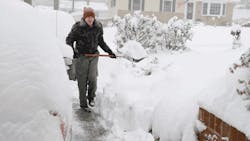About a million people experience falls every year, according to the Centers for Disease Control and Prevention (CDC), and approximately 20,000 people die annually due to fall-related injuries. Now that winter weather has arrived in full force and many parts of the country are experiencing snowy and icy conditions, play it safe when stepping outside to avoid painful and dangerous falls.
Mike Ross, author of The Balance Manual and exercise physiologist at Gottlieb Center for Fitness, part of Loyola University Health System, explained that some of the unavoidable bodily changes that occur as we age may affect personal safety. As we grow older, our balance deteriorates due to the weakening of muscles and change in sensory perception, especially in the ear structure. Equilibrium, or balance, is largely determined by the inner ear and the brain.
“As we age, our eardrums often thicken and the bones of the middle ear and other structures are affected. It often becomes increasingly difficult to maintain balance,” Ross said. “Aging also breaks down cells in the nervous system, which can often result in a delay in reflexes that can lead to susceptibility to injury.”
Ross offers the following eight tips to navigate slippery winter conditions safely this year:
- Check your footwear. Examine your shoes and boots for traction and determine whether it’s time for a new pair. Better traction can help keep you more stable on icy surfaces.
- Keep a shovel and salt in your house. Don’t keep these useful tools in the garage or other out-of-the-way spot – you want them close at hand so you can clear your sidewalk, porch and steps.
- Check the railings. Examine the railings leading up to your front door to ensure they're sturdy and capable of supporting you if you slip.
- Bring a cell phone when you leave the house. If you fall, it may be hard to get up. Carrying a cell phone whenever you go out can bring peace of mind.
- Slow down. Allow extra time if it's slippery out. When you rush, you end up pushing the limits of your sense of balance. And remember: It’s better to be a little late than rushing and causing a fall.
- Ask for help. If you have to walk across an icy sidewalk or parking lot, try to find a steady arm to lean on. Most people are happy to help someone navigate a slippery walkway, so you just have to ask.
- Have a plan. When you are going out, ask yourself, "If I slipped and fell here, what would I do?"
- Strengthen your legs. Strong leg muscles can help you steady yourself if you slip. And if you do fall, they make it a lot easier to get back up. You should exercise your legs regularly to keep them strong. Try walking up and down your stairs repeatedly or do a set of 10 squats out of a chair a couple of times per week.
“Many falls can be successfully avoided or the impact minimized by applying a few basic strategies,” Ross concluded.
About the Author

Laura Walter
Laura Walter was formerly senior editor of EHS Today. She is a subject matter expert in EHS compliance and government issues and has covered a variety of topics relating to occupational safety and health. Her writing has earned awards from the American Society of Business Publication Editors (ASBPE), the Trade Association Business Publications International (TABPI) and APEX Awards for Publication Excellence. Her debut novel, Body of Stars (Dutton) was published in 2021.
